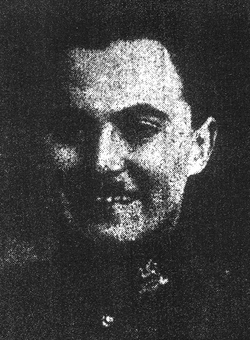
George was born in Bolotwa, a town in Eastern Cape, South Africa. He came from a line of men who had served in the military. His father, WC Prime Jones, a Government Magistrate in Whittlesea, South Africa, had previously served with the Cape Mounted Rifles; his grandfather was Captain Richard Walker Jones, of Park Place, Sevenoaks Common, and his great-grandfather was Captain Richard Jones, RN, of Warehorn, Tenterden.
George lived with his aunts at ‘Ampthill’, 46 Pennington Road, Southborough, and he was educated at Skinners' School in Tunbridge Wells, where he had been a member of the Officers’ Training Corps. George was well-known locally, particularly as a sportsman. A keen cricketer and footballer, he had played for Tunbridge Wells, Southborough, and several times for the Rangers (his prowess as a goalkeeper was “envied by every custodian in the district. Standing 6 ft 4 ins, his reach is a great asset, and he knows how to make the best use of it”). He had been asked to play for Tottenham Hotspur, and soon after joining the Army he had turned out for Brighton and Hove Albion.
‘He had an extremely narrow escape, a bullet striking his belt and glancing off, inflicting a flesh wound. A few minutes after - before he had recovered from the shock - a shell burst just behind him and rendered him unconscious for half an hour from concussion.’
About six months later, in the early Spring of 1916, George was attached to the Royal Flying Corps, then in its infancy, having been formed just four years earlier in April 1912. The Courier of 2 June 1916 reported that he "entered into the study and practice of aviation with the same enthusiasm that he has shown in everything else. He had gained his pilot's certificate, and in about a fortnight or three weeks would probably have gained his 'wings'."
On the morning of 28 May, 1916, George went up as a passenger with Lieutenant Tennant, who had 20 hours flying time under his belt, for a practice flight from a local aerodrome in Kent. A police constable was on duty at the field being used by the authorities as a landing site, and at the inquest held two days later he reported that at 11am he "saw the biplane descend with Lieutenant Tennant acting as pilot, deceased being in the observer’s seat. They got out, had a smoke and a chat, and were both very cheerful, commenting on the fine morning. They stayed about a quarter-of-an-hour, and then prepared to return. The machine was not more than 100 feet up, when it appeared to gradually turn to the left, and then side-dipped, taking a nose-dive to the ground. Witness got to the spot two or three seconds after the machine fell, and found that Lieutenant Tennant had been thrown two or three feet clear of the machine, and was apparently badly injured, but was still living. Captain Jones was still in the machine, but was quite dead. It took about three-quarters-of-an-hour to get him out. Witness described his injuries, and said death was absolutely instantaneous. His wrist watch was still going when he was got away from the machine."
George Jones was given a military funeral at Southborough Cemetery, his coffin borne from his home on a gun-carriage drawn by six black horses. The mourners included his uncle, aunts Florrie, Leila and Maud, and officers and men of the Royal Flying Corps, but sadly, several members of his family were unable to arrive in time. There are several other airmen buried in Southborough Cemetery, but Captain Jones must surely be the earliest.
As regards Lieutenant Tennant, this link indicates that he survived this accident, only to be killed one year later on the Somme.
His photograph can be seen here.
For an account of the conditions encountered by RFC airmen in France, I can highly recommend this link, featuring Fighter Pilot Cecil Arthur Lewis, one of the founders of the BBC (unless the current Government's commands to the BBC have meant dismounting this section from the BBC's superb website!).

 RSS Feed
RSS Feed
